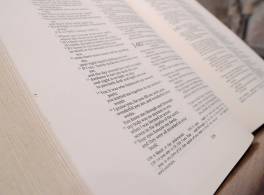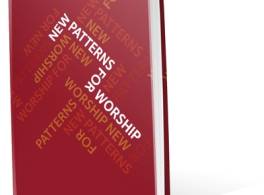Stories from the four churches
♦
St Ann’s has plenty of rooms and people, and so is able to provide a teaching programme for the children whenever they are not present in church for the whole of the service. At a recent meeting of the PCC, it was felt that although the children benefited from their own groups for teaching, they missed out on experiencing the worship of the whole church. It was decided, therefore, to have more services which were suitable for the whole church community to worship together. The worship planning group were sent off to come up with some ideas for involving the children in the whole of the liturgy. They suggested these areas for consideration:
* Involving the children in preparation for worship – choosing hymns, preparing the holy table, giving out hymn books, joining in a procession, using opening responses which the children can join in (with simple or repetitive responses such as A28).
* Having a worship theme table (see here) reflecting the theme of the service at different points in the church building in different seasons.
* Using more visuals in all parts of the service, for example images on OHP or video projection, in the Penitence or Prayer sections or as an accompaniment to one of the readings (see here).
* Making sure that some of the Liturgy of the Word actively involves children, either in the presentation of the readings, or in taking part in or responding to the sermon; the Gospel might be preceded or followed by a free adaptation, transposing it to a modern setting, perhaps in dialogue form.
* Making more use of movement, letting the children move around the spaces in the church at appropriate moments, perhaps gathering under the big cross in the north aisle for the Prayers of Penitence, or around the font for the Affirmation of Faith.
They also suggested that some of the worship leaders and planners might visit the church junior school, and find out how interactive the lessons were, to gain more understanding of what the children were used to.
♣
St Bartholomew’s has Sunday school two weeks in the month and an all-age worship service once a month. On the fourth Sunday worksheets and pens are provided for the children to complete during the sermon. The worship leaders are working hard to find ways of integrating the children’s contributions into a service which has to cater for everyone in the village. Some of the parents involved in planning and leading also teach in the Sunday school, so sometimes the children prepare something one week in Sunday school for use in worship the following Sunday. This week they have produced a collage of loaves and fishes for a temporary altar frontal. The intercessions often involve the children, as well as the rest of the congregation, in writing their own prayers or suggesting topics for prayer. Sometimes symbols are used to help people focus their prayers. A group of mums and older children are willing to cut out paper shapes for prayers to be written on, or to give a lead in preparing items for prayer beforehand, e.g. bringing newspaper cuttings to church as a starting point for the prayers.
There is a music group which sometimes leads the worship. It usually consists of a couple of adults and several children of differing musical abilities playing assorted instruments. Sometimes this makes for interesting sounds, but the congregation are glad to have the children’s offerings. The children in turn are very enthusiastic and have a wide range of favourite music encompassing all styles.
♦
St Christopher’s has few children, as there are not many living in the parish. Activity sheets based on the lectionary readings are provided for the children who come on Sunday mornings. They refer to what the children will be doing later in the service. People bring their concerns to the church for prayer, and the children are encouraged to join in as well. Some of the older children occasionally read the lessons, or take part with adults in a dramatic reading for several voices. Sometimes a small group of adults and some children meet together a few weeks before a service to prepare banners, or a throw-over frontal for the altar, to reflect the theme of a special service.
The alternative provisions from Common Worship are often used, such as a responsive form of confession. The question and answer form of the Creed is used at both all-age services and communion services, so that the children and families who start to come to communion after having come to all-age worship are familiar with at least some of the liturgy. In the communion services where children are present, the shorter Eucharistic Prayers are usually used, and sometimes the children are invited to come and stand around the altar, or help to serve. They regularly use the responsive Prayer at the Preparation of the Table (Common Worship, page 292, Prayer 8), as they bring the bread and wine:
With this bread that we bring
we shall remember Jesus.
They have occasionally experimented with longer insertions at this point (see here) and taken advantage of the provision for varying the words of the Preface in some of the Eucharistic Prayers (see Note on Thanksgivings in Resource Section G, here).
♠
Today is the monthly all-age service at St Dodo’s, to which children and families have been invited, and there is a baptism. The young people are taking part in a drama (the Good Samaritan – again!) but once this is over they get restless, as the remainder of the service is not especially geared to them. The baptism sounds like a long monologue, and the music consists of Victorian hymns that are all unfamiliar. The children in the Sunday school have been asked to lead the prayers, so the Sunday school teachers have written them on pieces of paper, and the children have some difficulty reading them. It is also difficult to hear what they are saying as the microphone is not adjusted to their height. There are some Bible story books (given to the church ten years ago) and colouring things at the back of the church, but most of the children are now too old for them, and feel that they have rather outgrown such entertainment.

Ideas for visual accompaniment to readings
* Mime.
* Tableau.
* Drama.
* Dance.
* Puppets (shadow puppets are more easily seen by large numbers).
* Projected slides or OHP transparencies of the story drawn by the children.
* A procession of items referred to in the reading, brought up and arranged in a suitable space near the reader. (This has the advantage that it introduces movement without requiring a great deal of rehearsal. It provides concrete visual images and the people carrying the things up have to listen to the reading so as not to miss their turn.)

Worship theme table
Such a table, with items reflecting the theme or biblical material to be heard in the service, provides a concrete object of interest on arrival and throughout the service, both for children and adults. For example, on the first Sunday in Lent the table is below the pulpit. There is a large cloth covered with sand, in which are strewn a few large pebbles and the odd withering plant. Or on the fourth Sunday after Easter in Year A, there is a green felt cloth, a few toy lambs, a shepherd’s crook or a large walking stick, a leather water bottle or perhaps a sheepskin. A group of people is always responsible for the preparation of the theme table and many people in the congregation are now used to contributing suitable items. Sometimes one of the flower arrangers provides an appropriate arrangement to complement the images and sometimes items are used during the address and then replaced.

Preambles before the Eucharistic Prayer
This might be a set of biddings or reasons for giving thanks, spoken by children or others, before the opening dialogue. Jewish-style questions and answers such as the following might be compiled, perhaps to echo the theme of the service. A child might ask the questions, which the president or deacon might answer, and not all questions need be attempted every time.
Q Why do we give thanks and praise to God?
A Because he has created all that is, and he has given us life. He is Lord of all, and yet loves each of us.
Q Why do we remember Jesus?
A Because he was sent from God and he gave up his life for us on the cross. God raised him from the dead so that we might see that death is not the end, but the beginning of a new life, the life Jesus showed us how to live.
Q Why do we use bread?
A Because Jesus took bread at the Last Supper. It is a sign of Jesus feeding us as we share with others around his table.
Q Why do we use wine?
A Because this wine is a sign of Jesus’ saving love, poured out for us when he died on the cross.
(or)
Q Who are we remembering and who is here with us?
A Jesus Christ the Lord who lives today.
Q Why do we take this bread?
A To show that his body was given up to death for us.
Q Why do we take this wine?
A To show that Jesus shed his blood for our sins.
Q Why is there one loaf and one cup?
A Because we are one family; we belong to each other like the parts of a body.
Q Why do we come to his table?
A He invites us because he accepts us. We are his people and we share in his heavenly life.
Q For how long will Christians celebrate like this?
A Until Jesus comes to take us to be with God in heaven.
Whatever happens, the actions, style and approach of the president, while being accessible to children, should make clear that the Eucharistic Prayer which follows is addressed to God, in whose presence it is right to be filled with awe. The sense of mystery should not lose out to a chatty educational or instructional approach.
Discussion starter: All-Age Worship
If you have an all-age service in your church, compare it with what is described here.
If you are considering starting an all-age service, these questions and lists might help you compile a statement which begins ‘Our all-age worship will be like this….’ Try some brainstorming, when people list answers to questions such as:
* What is our aim in starting an all-age service?
* What are the arguments against it?
* What are the arguments in favour?
What is our aim in starting an all-age service?
* Who is the service for? Who might come to all-age worship?
* Nuclear families with parents and young children.
* Children from the Sunday School or regular children’s activities.
* Single parent families.
* Single people.
* Older people.
* Those whose children have grown up and moved away.
* Teenagers.
* Visitors to the church or area.
* Younger married couples.
* Is the service basically the Eucharist (Holy Communion) with a new title to emphasize that it is for the whole church community, or that provision is made for children as well as adults?
* Either for this or for a non-eucharistic service, are ‘All-Age Worship’, ‘All-Age Service’ or ‘All-Age Communion’ better titles than the often-used ‘Family Service’, to stress that people of all ages can worship together? Would it be better to invent a new, local name for the service?
* Is it just a way of giving children’s workers a monthly break?
What are the arguments against all-age worship?
* Worship may seem ‘childish’; the focus is on children to such an extent that adults are forced to deny their adulthood by joining in.
* If proper care is not taken it can focus so strongly on the nuclear family that it makes those in other styles of household – the single, bereaved, divorced and elderly – feel less part of the church family.
* Both structure and content can be so free and variable that people may see no links with traditional Anglican worship.
* It can fail to act as a ‘bridge’ to more main-line eucharistic or Morning Prayer worship: some worshippers never move on from the monthly ‘all-age service’.
* Worship can become banal, superficial, focused on learning rather than worship, dominated by a strong teaching aim or a ‘compere’, and provide little God-centred worship.
* It can easily become all-age learning rather than all-age worship, because it is much easier to find resources for the former than the latter.
* Worship depends on the whim of the worship leader because so much is new; and because some people think it is not a ‘statutory’ service, there is sometimes little or no consultation with the PCC.
What are the arguments in favour of all-age worship?
* All-age worship can provide a place where those unfamiliar with formal worship can begin to feel at home. One reason for this is that it can be a bridge, in reflecting local culture more easily than the rest of the Church’s worship. Another reason is that people sometimes welcome the excuse to accompany their children, and then find that they understand teaching which is simple and visual, and sometimes at a more ‘introductory’ level.
* It is a place where genuine intergenerational activity can take place, with adults and children learning from each other and worshipping together.
* It can help regular church attenders to discover new dimensions in worship.
* It provides an opportunity for people to grow and use their gifts by sharing in planning, leading and contributing to worship.
* It provides a way of introducing new elements into worship (in a congregation likely to be less critical of them?) – drama, dance, audio-visuals, new hymns or methods of teaching.
New Patterns for Worship, material from which is included here,
is copyright © The Archbishops' Council 2002 and published by Church House Publishing.


